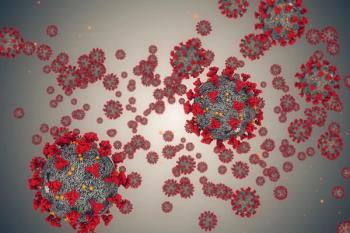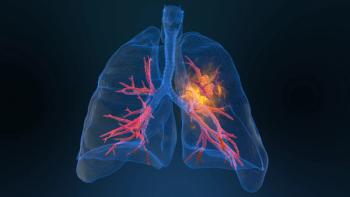
High-Dose Vitamin D Shows Limited Added Benefits in Hypertension
Two doses of vitamin D were investigated for their potential to have a positive impact on systolic and diastolic blood pressures when administered in conjunction with calcium.
Older adult individuals who are considered
Outcomes in a new analysis were evaluated at 6 months and at 12 months in a multicenter, double-blind, randomized controlled trial of 221 ambulatory older patients classified as overweight, and the above benefits were seen regardless of vitamin D being given at 600 IU/day compared with 3750 IU/day. In 2010, the recommended daily dose of vitamin D was upped from 200 IU/day to 600 IU/day for most adults and children, as was the safe upper limit for older children and adults from 2000 IU/day to 4000 IU/day, marking the first change in vitamin D guidance since 1997.2 Since 2010, the National Academy of Medicine (then known as the Institute of Medicine [IOM]) has recommended 600 IU/day for persons aged 1 to 70 years and 800 IU/day for adults older than 70 years, and a safe upper limit not to exceed 4000 IU/day for any person older than 8 years.
Most participants in this analysis were female (55%), with a mean (SD) age of 71.1 (4.7) years. The most common comorbidities were prediabetes (69%), hypertension (65%), and dyslipidemia (64%), and 67% overall had 1 (31%) or 2 (36%) comorbidities. Forty-eight percent were currently being treated for hypertension, with a majority having a blood pressure of 130/80 mm Hg or higher and being managed with β-blockers (16%).
“High vitamin D doses compared to the IOM’s recommended daily dose did not provide additional health benefits,” senior study author Ghada El-Hajj Fuleihan, MD, MPH, FRCP, of the American University of Beirut Medical Center in Beirut, Lebanon,
Among several prominent adverse health conditions associated with vitamin D deficiency, the study authors list cardiovascular disease, immunological diseases, and cancer.4,5 Still, they said the overall evidence from other randomized trials conflicts too much, and so they performed their subanalysis of data from a completed trial (NCT01315366).
The Results
After being randomized to the low-dose (n = 111) or the high-dose (n = 110) cohort,1 the authors saw significant reductions in both systolic blood pressure (SBP) and diastolic blood pressure (DBP) at 1 year: 3.5 (18.7) mm Hg (P = .005) and 2.8 (12.1) mm Hg (P = .002), respectively. For those in the high-dose arm, the overall decrease in SBP was 4.2 (19.4) mm Hg (P = .023) compared with 2.8 (18.1) mm Hg (P = .089) in the low-dose arm. The corresponding drops in DBP were 3.02 (12.1) mm Hg (P = .01) and 2.6 (12.1) mm Hg (P = .089).
Similar overall percentages of participants saw decreases of 4 or more mm Hg in their SBP (42.3%, low-dose arm; 42.7%, high-dose arm) and 2.5 mm Hg or more in their DBP (46.8% and 44.5%, respectively). Type of BP medication did not affect these outcomes.
Stratifying by BMI only, at 6 months and at 12 months compared with baseline, the participants with a BMI above 30 kg/m2 saw significant decreases in their SBP no matter the Vitamin D dose:
- High-dose group: from 132.9 (17.6) to 129.3 (12.6) to 125.8 (11.5) mm Hg (P = .006)
- Low-dose group: from 132 (17.2) to 127.1 (16.4) to 124.5 (16.9) mm Hg (P = .024)
DBP only significantly decreased compared with baseline among the high-dose group:
- High-dose group: from 77.3 (10.6) to 74.3 (9.1) to 73.3 (7.9) mm Hg (P = .020)
- Low-dose group: from 77.3 (11.4) to 73.5 (9.9) to 74.5 (10.5) mm Hg (NS)
Antihypertension medications had a positive impact on SBP and DBP overall (P = .012), but when drilling down to each, only the DBP changes were considered significant for the low-dose group (P = .103). When considering BMI and the effects of antihypertension medications, BMI above 30 kg/m2 was linked to statistically significant decreases in SBP overall and at 6 and 12 months in both dose arms, while DBP only dropped overall and in the low-dose group.
Adjusting for age, sex, BMI, change in antihypertension medications during the study, and time on BP medications according to the specific medication with a linear mixed model did not show correlations with differences in SBP or DBP between the high vitamin D dose and the low vitamin D dose. However, associations were seen between BMI and baseline SBP for overall SBP and between BMI, sex (lower in women), and baseline DBP for overall DBP.
Next Steps
The authors note that low levels of 25 hydroxyvitamin D (25OHD) may point to the beneficial impact of vitamin D among their study population, with previous research showing a relationship between 25OHD and BP.6-9 As well, their data demonstrate that it is important to consider certain demographic factors and underlying health conditions when evaluating the potential impact of vitamin D on BP.1
Additional strengths of their data come from the trial design and length, quality control measures, minimizing for potential confounders, and the use of the linear mixed model. Limitations are that they focused on an older patient population that was overweight, which limits generalizability to a wider population; that this was an exploratory analysis; and the low power of their subgroup analyses.
“Individual patient-level meta-analyses are needed to validate our findings,” the authors concluded, “and if confirmed, to investigate the optimal dose to be used.”
References
1. Rahme M, Al-Shaar L, Tamim H, El-Hajj Fuleihan G. Blood pressure decreases in overweight elderly individuals on vitamin D: a randomized trial. J Endocr Soc. Published online November 12, 2024. Accessed November 12, 2024. doi:10.1210/jendso/bvae168
2. Everyone should boost intake of vitamin D, IOM says. News release. University of Rochester Medical Center. November 29, 2010. Accessed November 11, 2024.
3. Vitamin D supplements may lower blood pressure in older people with obesity. News release. Newswise. November 12, 2024. Accessed November 12, 2024.
4. Holick MF. Vitamin D deficiency. N Engl J Med. 2007;357(3):266-281. doi:10.1056/NEJMra070553.
5. Bouillon R, Van Schoor NM, Gielen E, et al. Optimal vitamin D status: a critical analysis on the basis of evidence-based medicine. J Clin Endocrinol Metab. 2013;98(8):E1283-E1304. doi:10.1210/jc.2013-1195
6. Burgaz A, Orsini N, Larsson SC, Wolk A. Blood 25-hydroxyvitamin D concentration and hypertension: a meta-analysis. J Hypertens. 2011;29(4):636-645. doi:10.1097/HJH.0b013e32834320f9
7. Ke L, Mason RS, Kariuki M, Mpofu E, Brock KE. Vitamin D status and hypertension: a review. Integr Blood Press Control. 2015;8:13-35. doi:10.2147/IBPC.S49958
8. Pilz S, Tomaschitz A, Ritz E, Pieber TR. Vitamin D status and arterial hypertension: a systematic review. Nat Rev Cardiol. 2009;6(10): 621-630. doi:10.1038/nrcardio.2009.135
9. Jorde R, Figenschau Y, Emaus N, Hutchinson M, Grimnes G. Serum 25-hydroxyvitamin D levels are strongly related to systolic blood pressure but do not predict future hypertension. Hypertension. 2010;55(3):792-798. doi:10.1161/HYPERTENSIONAHA.109.143990
Newsletter
Stay ahead of policy, cost, and value—subscribe to AJMC for expert insights at the intersection of clinical care and health economics.















































